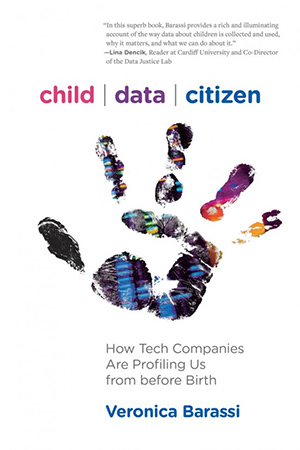Tech Companies Are Profiling Us From Before Birth

“Track your period, ovulation, symptoms, moods, and so much more in one beautiful app!” So begins a promotional blurb for Ovia, one of several fertility apps on the market boasting its ability to monitor women’s health and fertility cycles.
Tens of millions of prospective parents use fertility apps like Ovia, in addition to Google and other sites to search for information on how to conceive, meaning the datafication of family life can begin from the moment in which a parent thinks about having a baby. After conception, many of these families move on to pregnancy apps, the market for which has also grown enormously in recent years.

Tracking the health of the unborn and women is certainly not new, yet with the use of pregnancy apps, this surveillance and tracking has reached a new level. These apps are enabling a situation whereby corporations have access to a grab bag of personal data on the unborn, including not only health markers like weight and heart rate, but also cultural background, the parents’ thoughts, family ties, and family medical history, to name a few.
Once a baby is born, parents might use baby trackers or wearables to manage the baby’s routine and record sleep times, feeds, and bowel movements. Again, documenting these behaviors is not new. Families of newborns have historically jotted this information in journals. When my first daughter was born, my mother showed me the journal that she kept of me as a newborn. Written in black ink on yellow pages and in my mother’s familiar handwriting, there was a list of feeding times, naps, and diaper changes. She kept the journal in a drawer of her study and no one outside our family had access to it. Consequently, even if the tracking of the baby, like the tracking of the unborn, has always existed, baby apps — with their charts, reports, and interactive elements — have greatly transformed this historical practice and given it a new datacentric dimension.
I remember being especially fascinated by one user who wrote how upset she was about losing her “kick count data” and ended her comment with an angry, “Shame on you!”
As one respondent — the mother of a 13-year-old and a 6-month-old baby — told me when I was conducting research for Child | Data | Citizen, a three-year-long research project that explores the datafication of childhood in the era of big data and artificial intelligence, data tracking was key to the “running of her family life,” and she was particularly grateful for a baby-tracking app. “I love data when it comes to work,” Katie told me. “I love data when it comes to everything, because it gives you information and you can plan. I also use self-tracking apps for fitness for the same reasons.”
In her enthusiasm for data tracking, Katie was not alone. Many of the parents I interviewed shared her view about the importance of data tracking, especially during pregnancy and early infancy. In 2016, when I was carrying out research on pregnancy apps, I analyzed 3,570 reviewers’ comments of 10 of the most downloaded apps in the U.K. and the U.S. in 2015. The analysis enabled me to shed some light on parents’ attachment to the data they produce through data-tracking apps.
I remember one example in particular. On March 14–15, 2016, one of the apps I studied updated its features, and many users lost their data. The app was inundated with comments. Users expressed their outrage and demanded to have their data back. I remember being especially fascinated by one user who wrote how upset she was about losing her “kick count data” and ended her comment with an angry, “Shame on you!”
Why Data Tracking Matters
Some would describe parents’ attachment to data as a form of “data obsession” or “data fetishism.” Yet anthropological literature on the fetish shows that humans often don’t fetishize objects (or data) as a form of lunacy, they fetishize them because these objects embed, represent, and remind them of their social relationships. At times, parents form a deep emotional bond with their data-tracking technologies because these technologies enable them to live and experience the important relationships in their lives. A user of one of the pregnancy apps that I analyzed, for instance, described the app as her “best buddy” helping her through “all the stages of pregnancy.”
Humans often don’t fetishize objects (or data) as a form of lunacy, they fetishize them because these objects embed, represent, and remind them of their social relationships.
Data tracking for family life matters, and it matters for a variety of reasons that reflect the plurality of data that we produce. We record data because we want to capture instances of our experience, and we feel an emotional bond to some of the data that we produce. On the day I discovered I was pregnant with my first daughter, I took a picture of my body with the Photo Boot app on my MacBook. Every week for nine months I documented my pregnancy. I also used the computer to take screen grabs of my sister’s and my friends’ reactions to the news of my pregnancy after I told them on Skype. I saved all my pictures in a folder, titled “family.” That data was so special to me — irreplaceable. When I thought I had lost it because my computer had crashed, I felt lost, angry, and terribly upset; when my tech-savvy friend told me that no harm had been done, I was excited and relieved.

It is not only photos that matter. The details of everyday life that can be recorded and captured, even the most mundane and ordinary details, also count. This is why data tracking can be so meaningful for families. The practice of documenting mundane details of everyday life existed well before the advent of social media and other data-tracking technologies, especially among families, explains Lee Humphreys in her book “The Qualified Self: Social Media and the Accounting of Everyday Life.” By looking at the social role played by diaries in the 18th century and throughout the 19th century, Humphreys, for instance, shows that everyday life was documented with precision in personal diaries. These diaries were interactive because they were often shared with family and friends and were also mobile, because diarists often used pocket diaries to record life in real time.
Data tracking in family life has a long history and a profound emotional dimension. But in the past, parents who used journals to track their families’ routines owned and controlled the data that they produced, because like my mother they owned their journals and often kept them in safe places. Today this data is stored, processed, and profiled in ways that escape parental knowledge and control.
In March 2019, for instance, the British Medical Journal published an international study that demonstrated that out of 24 mobile health (mHealth) apps, 19 shared user data with parent companies and service providers (third parties). They also showed that third parties shared user data with 216 fourth parties, including multinational technology companies, digital advertising companies, telecommunications corporations, and a consumer credit reporting agency. Of 216 organizations, only three belonged to the health sector. The paper also demonstrated that the data was shared with different Big Tech companies, including Alphabet (Google), Facebook, and Oracle, who occupy central positions within data-brokering networks because they have the means to aggregate and re-identify user data.
As parents buy into the promises of data tracking, they produce large amounts of children’s data that is then archived, analyzed, and sold; hence, they play an active role in the datafication of children. However, the datafication of children does not only occur because parents play an active role and use data-tracking technologies. In fact, not all parents use pregnancy and baby apps, and many parents that I met during my research often complained that data tracking was “too much work.”
Yet even among those families who do not use mHealth apps or wearables, children are nevertheless datafied from before birth. This is because they are exposed to the business models and the data-brokering practices of surveillance capitalism, which enable companies to track children from before conception.
The Datafication of Children: No Way Out
I never used an app, but Google and BabyCenter — and all their third and fourth parties — knew I was pregnant with A before my family knew. I found out I was three weeks pregnant on holiday. Google had to answer my following concerns: “Can I use a hot tub in early pregnancy?”; “Abdominal cramps in early pregnancy”; “Miscarriage risk when flying.” I found most of the answers I needed on BabyCenter, and because I had already studied their data policy, I knew that my data was recorded, processed, and shared with third parties. But what could I do? I needed answers, and online searches are part of my life. Yet it made me feel awkward to know that targeted advertisers knew I was pregnant and started profiling me before I even had the chance to share the news with my mom, dad, and sister.
Under surveillance capitalism, the profiling of the pregnant woman and the datafication of the unborn has become unavoidable. In 2014, for instance, Janet Vertesi, a sociology professor at Princeton, conducted an experiment: She wanted to see if she could keep her pregnancy secret from the bots, trackers, cookies, and other data sniffers online, which feed the databases that are then used for targeted advertising. She was aware that pregnant women are tracked more than other users, because data companies believe that to be able to identify one pregnant woman is worth as much as knowing the age, sex, and location of up to 200 people.
I knew that my data was recorded, processed, and shared with third parties. But what could I do? I needed answers, and online searches are part of my life.
In her article published in Time magazine in 2014, she explained that trying to hide her pregnancy made her look and feel like a criminal, because she had to employ different tactics such as using Tor as browser to access content of the BabyCenter. She thus came to the conclusion that trying to avoid becoming a “pregnant data subject” made her look not only like a rude family member or an inconsiderate friend, but like a bad citizen. For mothers-to-be like Vertesi, it is impossible not to be tracked and profiled as data subjects. In fact, the tracking of pregnancy and early infancy has become a fact of our datafied lives under surveillance capitalism, which families cannot avoid.
Early infancy is just the beginning of the datafication of children and their families. As children grow up, parents search Google with age-specific queries and land on web pages such as those of BabyCenter.com or BabyCentre.co.uk that are already structured around age (getting pregnant, baby, toddler, preschooler, big kid) and share this information with others.
The BabyCenter LLC privacy policy explicitly states the data collected is shared with their affiliates and third-party partners. It also mentioned at the time of this writing that the company has “A direct relationship with the following ad technology partners who may have information about you that may be used to personalize the advertisements you receive when using our Service: Google; Amazon; AppNexus; Brightcom; District M; DoubleVerify; Index Exchange; LiveIntent; OpenX Technologies; Salesforce; Sizmek; Smaato; Sovrn; Teads.TV; YieldMo; bRealTime/EMX.” Hence critical questions emerge regarding whether data companies know and share the exact age of children and have the technologies to track and follow them as they grow up.
However, the datafication of families and children is not only happening because families use apps, search engines, or social media, but also because, with the extension of surveillance capitalism, the society around them (e.g., the school, doctor, bank) is increasingly becoming automated and data driven. From doctor’s appointments to schools, from supermarkets to home technologies, family life is being surveilled, tracked, and analyzed in almost unimaginable ways.
The Datafied Family and Surveillance Capitalism
One of the big changes brought by surveillance capitalism is the introduction of the cultural belief that data offers us a deeper form of knowledge. According to Viktor Mayer-Schönberger and Kenneth Cuckier, the authors of an internationally renowned book on the big data revolution,
Data was no longer regarded as static or stale, whose usefulness was finished once the purpose for which it was collected, was achieved. … Rather data became a raw material of business, a vital economic input, used to create a new form of economic value. In fact, with the right mind-set, data can be cleverly reused to become a fountain of innovation and new services.
This is why we have seen a radical transformation in society. Governing institutions, educational bodies, health care providers, businesses of all kinds, and multiple other agents have started to turn every aspect of everyday life into data. In other words, they have bought into the logic of surveillance capitalism and have started to gather enormous quantities of personal data. During the Child | Data | Citizen project, I realized that parents were aware of this transformation.
When I interviewed Mike, a Los Angeles-based father of two kids aged 12 and 5 years in 2017, I asked him if he could imagine the data flows that came out of his family life. Mike laughed, looked up, and said, “massive amounts; unimaginable amounts.” Mike was aware that his family was being datafied not only because he used specific technologies (e.g., social media), but also because all the services that he encountered in his life were increasingly becoming data driven and automated (e.g., the energy suppliers, schools, doctors, among others). When Mike described the different data flows that came out of his family, he told me that he could remember a time when “There was not so much data out there.” In the last 10 years, he believed, something changed. There was a shift in the ways in which “society understood and valued personal data” and consequently in the amounts of data that was produced and collected. He described this transformation as a gradual push by companies, firms, and institutions to make you produce more and more data so that they could track it and profile it.
A few months later I was sitting in Dan’s living room in London. Dan was the father of two children, aged 7 and 5 years. Dan had left his job in information technology in advertising to become a stay-at-home dad and support his wife Jill’s career in marketing. That day when I asked Dan how he understood the datafication of his family, I was fascinated that he used almost the same words as Mike did. Like Mike, Dan talked about a massive change: “Everything, just everything, every shop, every bank, every organization pushed you to download an app or register.”
“Everything, just everything, every shop, every bank, every organization pushed you to download an app or register.”
It was striking that both of them perceived this transformation as gradual, as something that happened over the last 10 years and they gradually adapted to. Dan followed the transformation because he was working in the advertising business, and for this, he felt that he “was ahead of the game” in realizing that massive amounts of personal data (and family data) were being produced, collected, and processed. Mike realized that “something was going on with data” more than five years ago when he came to the conclusion that everything online was easily tracked and that all services were becoming digitized and data driven. For him the datafication of family life was something that he saw coming.
Mike and Dan perceived the transformation as gradual. Yet there is something profoundly unequal about the different ways in which the datafication of society has impacted highly educated or high-income families on the one hand and low-income or less educated families on the other.
The Unequal Impact of Datafication of Families
Both Mike and Dan were highly educated with high income and experienced the datafication of family life as a gradual transformation. Their experience of change radically clashed with the experience of those parents who came from a low-income or less educated background and who told me that they experienced the transformation as sudden, unexpected, and difficult to deal with.
Alexandra, for instance, was a low-income Hungarian immigrant working in London. Alexandra was married to Sid, who was from Nigeria, and had two children aged 8 and 10 years. She and her husband suddenly realized that their data was constantly collected because all the services around her were being digitized. “[There is so much data] because everything changed, everything went online. Like online banking, I am resisting it, but they make it impossible to go to the branch because they are closing branches down, so I end up using it. I don’t do much with it because I don’t understand it much,” she told me when we spoke in 2016. When I asked if she perceived the change elsewhere, here’s what she said:
Yes everywhere, you know in the shops the award cards. I have few of them. But also, the kids’ school now everything comes online by email, on a daily basis. It’s useful because there is so much information in relation to the school, so it is easier for me to be informed. But now they are trying to set up an online payment system so that I can pay the school meals, the school trips, etc. But I don’t use it because I don’t have online banking and so I prefer to pay every month. It’s that it is too difficult for me. I am sure that if someone would sit down with me and explain it to me, then I would get it. At the doctor I use the online booking; again I don’t really know how to use it, and it is frustrating. But our GP [general practitioner, doctor] has become so busy that sometimes I need to wait four or five weeks to see a doctor, but if I go online, I would find an appointment sooner.
For Mariana, like Alexandra, the change was quite sudden, and she felt that she lacked the skills to cope with it. Mariana was a Mexican immigrant who worked as a cleaner in Los Angeles and was a widow with four children, aged 11 to 23 years. “I know nothing about technologies” she told me when I started her interview. In contrast to her children who “were always on their phones or tablets,” Mariana managed not to use an email or a smartphone up until 2017. Then something changed; she was forced to go online. The school of her youngest children (11 and 13) started to rely on an online platform for homework and internal communications. She felt that she had no choice; she had to learn because she wanted to support them. Once she started going online, she suddenly became aware of social media and of how much information her children were posting online. “It was shocking and worrying, I did not know what to do,” she told me.
Mariana’s and Alexandra’s interviews were thus strikingly different from Mike and Dan. For them, the datafication of family life — which went hand-in-hand with the digitization of services — was more of a shock than a gradual process. They felt isolated and felt that they lacked the knowledge and skills to cope with the change.
The different experiences of Mike, Dan, Mariana, and Alexandra speak to the fact that social inequality plays a fundamental role in the way in which the datafication of family life and children is experienced and dealt with.
This inequality was also reflected in the ways in which they understood data privacy. If we compare Mariana’s and Mike’s understanding of the implications of the datafication of family life, they are strikingly different. Mike, like so many other parents that I worked with, felt that “he would prefer for the data to be private” but that “he had nothing to hide.” For Mariana, “the data out there was scary,” and a real concern, as she could clearly see how it could impact and harm her and her family.
It is precisely because the society around them is becoming more and more data-driven that parents no longer have a choice but to sign terms and conditions and give their consent for the lawful processing of children’s data. Despite that current data protection regulations focus a lot on parental consent, under surveillance capitalism, the notion of informed consent is exceptionally problematic. This is because, in the everyday life of families, digital participation is no longer only voluntary but increasingly more coerced as parents are forced to comply with data-driven and automated systems.
Datafied Children and the Problem With Consent
One day in Los Angeles in 2017, my family was invited to join a group of friends at an indoor play area in a shopping mall in the Valley. That day we had been stuck in traffic for more than an hour. When we arrived at the play area, P (who at the time was 4 years old) and A (at the time 6 months old) were hungry, frustrated, and whiny. As soon as I reached the counter to purchase the tickets, the employee behind the desk asked me to write down my children’s names, dates of birth, home address, my phone number, and email. I was also given the option to note my social media accounts. I felt annoyed. Why did I need to provide all that information simply to be allowed access to a play area? I really did not want to write down my children’s birth data and home address.
I asked the employee at the counter why they needed all that information. The employee looked baffled. Behind me there was a long line of parents and screaming children eager to get in. She looked up from her screen and replied: “It’s for insurance purposes.” I felt uncomfortable, and I asked whether I could opt out. She looked up again, this time confused, and told me: “The only way you could opt out is not to purchase the ticket.” I looked at P, who had just taken her shoes off and was waving at her friends. I felt I had no choice and gave away all our personal details without even reading the terms and conditions. That evening, when I got home, I found myself writing in my fieldnotes about that experience, about how it affected me and made me feel. The entry is one of the first entries in my database that explore parents’ relationship with terms and conditions.
In 2008, researchers calculated that reading all the privacy policies of the websites that users encountered in daily life would take approximately 201 hours a year for each U.S. user.
On an average family day, parents join new services, download new apps, connect with others on social media, or buy the latest home devices. In doing this, they sign off on the terms and conditions of a variety of services and give their meaningful consent that provides companies the right to lawfully process their children’s data. During my research, however, I came to the conclusion that — as it happened to me that day at the play area — the consent that most parents give is not informed or meaningful.
A great majority of the parents that I interviewed did not read the terms and conditions. This is not surprising. To read data policies requires an enormous amount of time that parents often do not have. In 2008, Aleecia McDonald and Lorrie Faith Cranor, two internet privacy scholars, calculated that reading all the privacy policies of the websites that users encountered in daily life would take approximately 201 hours a year for each U.S. user. Their calculation was based on the fact that to read an average policy takes from 8 to 10 minutes and that at the time, according to the data of Nielsen/Net Rating, an average U.S. user would visit 119 websites annually. Our digital environments have changed dramatically in the last 10 years, and there is no way to calculate how much time it would take for an average user to read all the privacy policies.
I had a vivid example of this during my research. One evening, in September 2018, I was in London and just got back from a night out with friends. I sat down at the computer to write a couple of emails. I checked Facebook and saw a link to an article on Asia Argento and the #MeToo Movement. I clicked on the link that brought me to an Italian magazine website. To comply with General Data Protection Regulations of the EU, the website asked me if I wanted to opt out personalization and find out more about the third parties with whom they were going to share my data. I clicked yes, and there was a long list of companies across the globe that had access to that insignificant click. Next to the name of each company there was a link to its privacy policy. I counted how many privacy policies I had to read to find out what happened to my personal data for a simple web search, and the result left me speechless: it was 439.
In my daily life I am constantly coaxed into acts of digital resignation.
Parents do not read terms and conditions because they would never find the time to read them. They also do not read them because they feel they have no choice: either they agree to the terms of service or they would not have access to important services in their life. This lack of choice is understood as the privacy trade-off in which users give up personal data just to be able to access specific platforms and services. Some experts have described this act as digital resignation because people resign to give up their personal data to enjoy a service. They argue that digital resignation has not only become a shared and normalized practice among users, but it is also constantly cultivated by corporations who encourage and reinforce it.
The day that I found myself signing off the terms and conditions of the play area, I resigned to give up the data of my children. I felt the pressure: Either I agreed to give up that data, or I had to tell my daughter that we were not going to meet her friends. In my daily life I am constantly coaxed into acts of digital resignation. Although I try to protect my children’s privacy, on a daily basis I buy into the privacy trade-off. During my research, however, I realized that surveillance capitalism does not only rely on the cultivation of digital resignation but also on the systematic coercion of digital participation. This is because, in many instances, the parents I was working with, and myself included, were not just resigning to digitally participate, they were actually forced to do so.
Children today are the very first generation of citizens to be datafied from before birth, and we cannot foresee — as yet — the social and political consequences of this historical transformation. What is particularly worrying about this process of datafication of children is that companies like Google, Facebook, and Amazon are harnessing and collecting multiple typologies of children’s data and have the potential to store a plurality of data traces under unique ID profiles. It is for this reason that we need to break down children’s different data flows and analyze the practices, beliefs, and structures that make these flows possible. Only by doing so can we grasp the complexity and breadth of the datafication of children.
Veronica Barassi is a Professor in Media and Communications at the School of Humanities and Social Sciences at the University of St. Gallen in Switzerland. She is the author of “Activism on the Web: Everyday Struggles against Digital Capitalism” and “Child Data Citizen: How Tech Companies Are Profiling Us from before Birth,” from which this article is adapted.
All names in the article are fictional to protect the anonymity of the interviewees.



